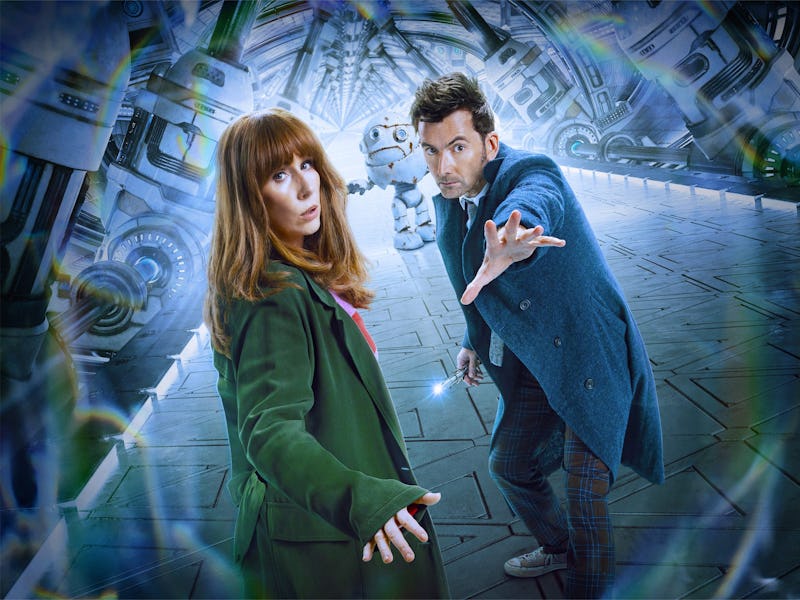The Doctor Who 60th Anniversary Specials Do Have Fan Service — It's Just Not What We Expected
We may not be getting a bunch of cameos, but the references to the legacy of Who is being celebrated.

For Doctor Who fans hoping that the three David Tennant and Catherine Tate 60th anniversary specials would recapture the Marvel-esque crossover feeling of 2013’s “The Day of the Doctor,” there is likely a tiny bit of a disappointment in the air. The hush-hush episode “Wild Blue Yonder” has aired, and despite fan predictions that it would be packed with cameos — including former Doctors — the reality is, that the episode was actually a small, compact episode of Doctor Who, with character-based stakes, and a uniquely creepy sci-fi concept.
But, for fans frustrated by what appears to be a lack of conventional fan service in the 60th anniversary specials, there’s one truth they may be overlooking: Both “The Star Beast,” and “Wild Blue Yonder,” are massively referential to the long history of Doctor Who. It’s simply that this kind of so-called fan service is perhaps a bit more subtle than what we’re used to in Marvel or Star Trek.
Spoilers ahead.
Ahead of the airing of “Wild Blue Yonder,” the director of the episode, Tom Kingsley pointed out on social media, that “ the story of ‘Wild Blue Yonder’ isn’t a secret because there are any surprise returning actors or villains.” Instead, it turned out we got a tight, psychological sci-fi thriller that showcased the talents of David Tennant and Catherine Tate in ways nobody has ever seen. True, there was no Matt Smith or Peter Capaldi cameo, but the episode was very much not about that kind of fan service.
The Classic Who episode, "The Sensorites."
However, from the beginning to the end, “Wild Blue Yonder,” did evoke beats from several classic Who adventures. The opening of the episode, in which there’s a strange mystery on a derelict spaceship feels like a big homage to the 1st Doctor serial, “The Sensorites.” In fact, the basic idea of the No-Things in “Wild Blue Yonder” feels close to “The Sensorites,” insofar as the alien menace thrives on information and autonomic functions from humans. In “The Sensorites,” the 1st Doctor encounters astronauts who have made themselves appear to be dead to avoid having their minds read by the Sensorites. Ditto “Wild Blue Yonder,” in which we learn an alien captain killed herself to avoid having her mind read, and that the No-Things can only be defeated by slow inaction.
Further, the idea of the Doctor boarding a derelict spaceship and then dealing with a mystery that is equal parts sci-fi and horror is a trope that pops up in the 4th Doctor story “The Ark in Space,” as well as the 12th Doctor near-swan-song, “World Enough and Time.” Fans have also pointed out that “Wild Blue Yonder” recalls the minimalism of both “Midnight” and “Heaven Sent,” from the 10th and 12th Doctor eras, respectively.
On top of all of this, the idea that the Doctor has to deal with a kind of evil doppelgänger of themselves was perhaps best depicted in the 4th Doctor adventure “The Face of Evil.” In fact, it would seem that the 14th Doctor even alludes to “The Face of Evil,” when he muses about a tribe worshipping the TARDIS. It’s not a one-for-one analogy, because in “The Face of Evil,” a tribe of humans feared a god called The Evil One, who, it turns out, looked exactly like the Doctor. Still, it feels like Russell T. Davies — a long-time fan of Doctor Who — is intentionally homaging the long history of the series without doing what we’ve come to expect from big crossover events like Spider-Man: No Way Home.
The Meep
If the 50th anniversary and “The Day of the Doctor,” was all about playing recent hits, then the 60th celebrations are focused on deep cuts. Both the Meep from “The Star Beast,” and the Toymaker from the upcoming episode “The Giggle,” are not famous villains whatsoever. And yet, with these specials, Davies, Tennant, Tate, and the rest of the cast and crew are giving very old Who concepts new life. In the case of the Meep in “The Star Beast,” that’s a Doctor Who creature that’s been around since 1980, but has never been fully realized in the flesh — or the fur. This doesn’t mean scores of fans were clamoring to see a live-action Meep, but Doctor Who gave fans that gift anyway, even though they didn’t know they really wanted it.
In a sense, that’s what’s happening with the Doctor Who 60th anniversary episodes. These are presents we’re unwrapping in which we already knew what we were getting based on the shape of the box. Instead, like a gift from someone you love, Doctor Who is giving fans things we never even considered we wanted. But, if you think about it, these gifts might be better than what we thought we wanted in the first place.